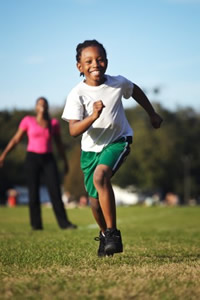What is the musculoskeletal system?
The Musculoskeletal system is made up of bones, joints, muscles and all the bits that connect them together.
Children’s Musculoskeletal Physiotherapy addresses problems relating to bones, joints, muscles and ligaments. When a referral is made to our service the referral is looked at by a Physiotherapist, who decides which team it would be best for the child or young person to be seen by. The Children’s MSK Physiotherapy service will often see children with:
- Soft tissue injuries / joint pains: related to a known condition or potentially due to other factors such as rapid growth or inactivity.
- Sports injuries – often overuse injuries.
- Children where there are concerns about how they are walking or if their walking pattern has changed.
- Children with rheumatological conditions such as Juvenile Idiopathic Arthritis
The aim of musculoskeletal physiotherapy is to support the return to normal function and sporting activities and to educate people how to self-manage their own conditions.
Who do we see?
We see children and young people who have been referred to physiotherapy by a health professional, are in full-time education and have musculoskeletal difficulties that require short term rehabilitation. If the young person referred is over 17.5 years of age, we may redirect the referral to the adult MSK service if it is appropriate to do so.
What to wear to the appointment:
We may require your child to undress to an appropriate level to carry out a complete assessment. We recommend that your child wears loose fitting and comfortable clothing. If they have been referred due to concerns about their back or arms, a vest top is recommended. Shorts are recommended for lower limb concerns.
About your appointment:
If you are under the age of 16 you must be accompanied by an adult with parental responsibility.
Your physiotherapist will ask you questions about your injury/problem, how you are feeling and what impact your symptoms are having upon your ability to take part in normal daily activities and the things that you enjoy. Then they will usually examine the affected area.
Once the assessment is completed, you and the physiotherapist will agree a treatment plan and if further physiotherapy is needed goals will be set, which will help us all to know what affect the physiotherapy is having.
Your physiotherapist will let you know if you need another appointment.
Treatment:
All referred children and young people will receive relevant information and have access to the website.
Treatment may involve the following:
- Education- it is important that you and your child understand what is causing the problems and how you can best help yourself to manage them.
- Advice- many conditions may not require treatment but advice on how to manage symptoms.
- Exercise rehabilitation- this is usually carried out in our clinics, to resolve muscle weakness, balance problems or muscle restrictions. This may involve 1-2-1 sessions with a member of the physiotherapy team, or group exercise classes and will depend on the individual needs of your child.
- Home exercises- you will be given exercises to do with your child at home to continue the work carried out in your appointment. These are a key part of the physiotherapy treatment.
- Soft tissue techniques
- Taping- hard or elastic tape to alter function.
Physical activity guidelines for children
Children between the ages of 5 and 18 years should be doing regular physical activity in order to maintain their health. If your child is not physically active this may be the cause of the issues they are experiencing. Children aged 5 to 18 should:
Aim to do at least 60 minutes of moderate to vigorous physical activity every day.
Take part in a variety of different physical activities across the week.
Limit prolonged periods of sitting or lying down during the day.
‘Moderate physical activity’ would be anything that raises a child’s heart rate, causes them to breathe faster, and makes them feel warmer. Further information is available by clicking the links below.
If you are unlucky enough to get a minor injury, follow the following advice:
o R – rest the injury. Try not to use the injured area.
o I – ice the area. When you ice an area you must have some protection between the ice and your skin (i.e. a tea towel or sock). Ice should be applied for a maximum of 5-10 minutes and the area will turn red. Don’t ice more than once an hour.
o C – compress the injured area. This means applying pressure on the area that is injured to prevent swelling.
o E – elevate the injured area. This means lift the area above your trunk. This prevents swelling.
If you have any concerns go to your GP, walk in centre or A+E
Please refer to the Keeping Healthy tab for further information
